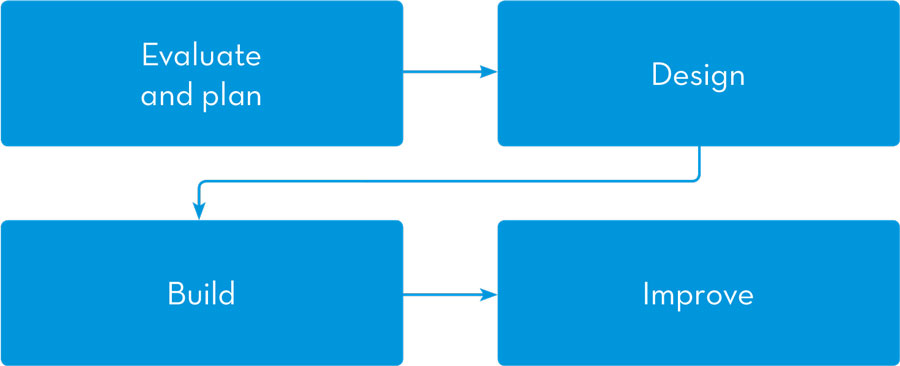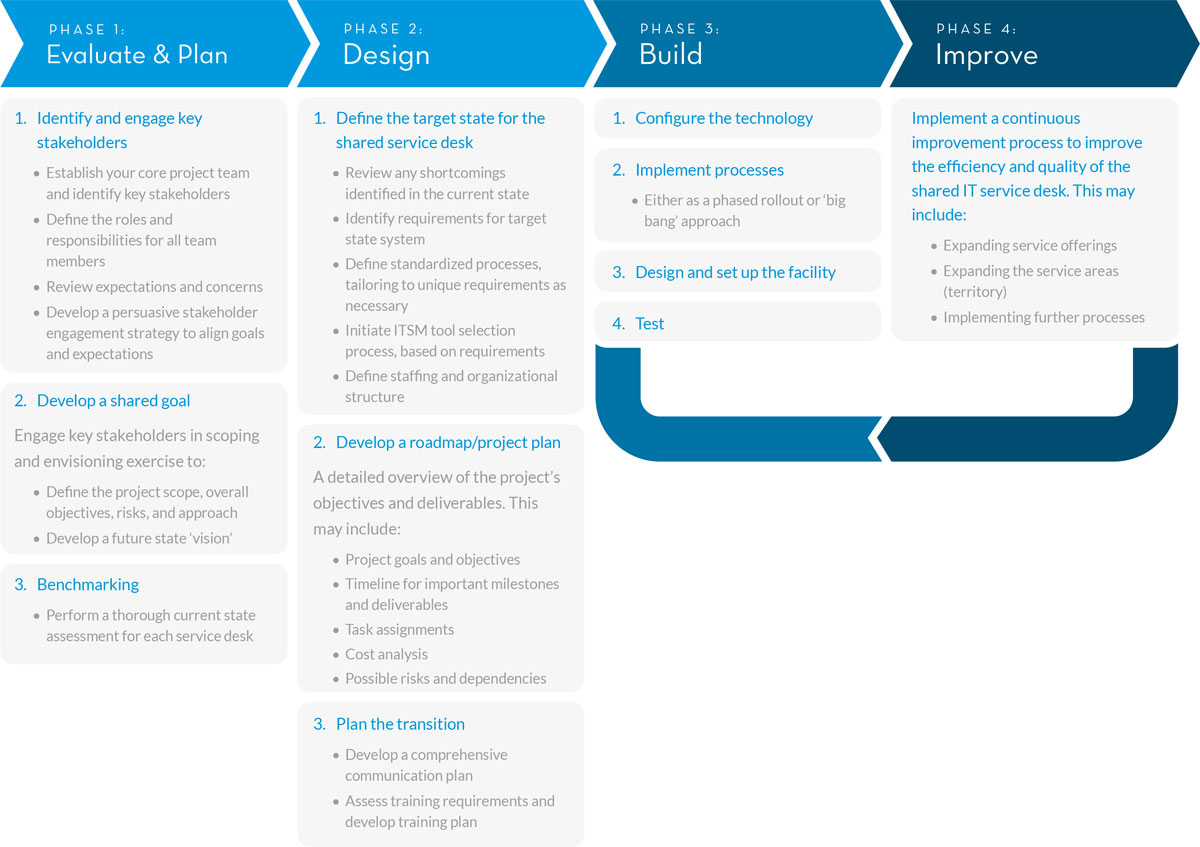Industry
Uses
Flexible Options
Services


Faced with the challenge of reduced central funding, local government authorities are under increasing pressure to cut staffing and operational costs, while still upholding the mandate to deliver value and efficiency to the communities they serve.
For already stretched local authorities looking to do more with less, implementing a shared services strategy is an attractive option. Done right, shared services as a service delivery model can offer a range of benefits, such as a reduction in labor costs, improved customer service, increased transparency and governance, and the standardization of processes.
Government IT departments in particular can benefit from the consolidation of IT service desks, either internally or in partnership with other local authorities.
This paper is aimed at IT managers tasked with implementing a shared IT service desk tool and will discuss benefits and common pitfalls, as well as offer insights into developing a shared service desk strategy.
There are many advantages associated with sharing a centralized IT function, notably in terms of cost savings.
A well-implemented shared services strategy can help businesses reduce total support costs by leveraging economies of scale. Collaboration helps drive down the cost of tool procurement through the elimination of duplication and savings on license fees.
In addition, increased purchasing power means that you have better leverage to negotiate volume discounts on license costs and can afford higher end software solutions.
Significant cost benefits can also be achieved by rationalizing the number of applications you have deployed in your organization. While multiple departments may not use what they consider a ‘service desk tool’, they almost inevitably will be using some kind of third-party software to manage their service provision. For every third-party app you support, you will incur the following kinds of costs every single year:
Consolidation drives down the marginal costs of the selected application. This means that for each application you retire from your organization, the marginal increase in cost on the shared platform is always going to be less than the true cost of ownership of the application being retired.
These numbers can, and should, be quantified before initiating a shared service desk project, in particular the direct costs:
Beyond cost benefits, centralization and standardization can also improve service delivery and customer satisfaction. A consolidated service desk can help drive the following further improvements within your organizations.
Despite these many benefits, there are also challenges in successfully implementing a shared service desk tool.
IT leaders are faced with many challenges when implementing a shared services model. These may include prohibitive set-up costs, lack of expertise, an over-reliance on cost recovery above service delivery and technical issues.
This section highlights two common barriers to implementing a successful consolidated service desk.
As mentioned in the previous section, the ability to streamline and standardize processes is one of the many benefits of implementing a shared IT service desk. While defining standard processes can indeed increase productivity, improve quality and reduce costs, blindly enforcing homogenous processes can be detrimental to the business.
Individual departments that require a certain degree of responsiveness to deliver on the unique demands of their customers, may feel pressured to compromise on process or requirements in order to consolidate.
Selecting an ITSM tool that is easily configured (NOT customized or coded) to suit the unique requirements of your various business units will not only enable you to define standardized processes, but also allow for the flexibility to tailor requirements as necessary.
In many cases, coming to grips with the technical aspects of implementing a centralized IT function, such as designing processes, defining requirements and tool selection is the easy part.
Often, the greatest challenges to building a consolidated service desk are related to people. Organizational resistance to change and internal politics are the largest barriers to successful service desk consolidations.
In order to overcome organizational resistance to change, it is essential to engage key stakeholders from the outset. Garner support by addressing any concerns that may be contributing to internal resistance and putting in place a comprehensive communication plan to ensure visibility of project goals and progress. Encouraging key personnel to become actively involved in scoping and envisioning exercises will help you to pave the way to a successful collaboration.
Alemba recommends the following high-level approach to developing a successful service desk consolidation strategy.


Kirklees Council leverages Alemba Service Manager (ASM) to streamline their IT Service Management, enhancing self-service capabilities and IT operations across the borough. Through their partnership with Alemba, Kirklees Council has transformed its IT services, achieving greater efficiency, user satisfaction, and alignment with ITIL best practices.
St. Helens Council, serving 180,000 residents and over 7 million annual visitors, became the first UK local authority to achieve ISO/IEC 20000 certification with Alemba Service Manager (ASM) playing a pivotal role. The Council selected ASM to support their digital transformation efforts and raise the standard of IT service delivery across the organization.
A leading UK-based food manufacturer partnered with Alemba to roll out automated, scalable service management portals for Logistics, IT, and HR teams. The Logistics portal was a direct requirement for post-Brexit regulations for the export of food products. Alemba Service Manager (ASM) enabled the customer to deliver department-specific portals, rapidly deploy self-service workflows, and integrate across multiple business-critical systems.
The Indiana Department of Revenue transformed its IT operations with Alemba Service Manager, automating processes, enhancing compliance, and delivering seamless service to over 1,000 users across 10 departments.
Frimley Health NHS Foundation Trust transformed IT Service Management with Alemba Service Manager, streamlining workflows, enhancing efficiency, and delivering measurable improvements - including increasing CSAT to 80% and an 82% reduction in escalations within three months.
Te Herenga Waka - Victoria University of Wellington uses IT Service Management tool, Alemba Service Manager (ASM), to streamline ITSM, enhance customer satisfaction, and achieve process efficiencies across multiple departments.
A New Zealand Government agency partnered with Alemba to enhance their IT service management (ITSM) capabilities, transforming their operations into a fully functional enterprise service management platform. Alemba Service Manager helped the agency streamline workflows, increase automation, and efficiently manage service requests for multiple agencies while maintaining a shared services model.
Luton Borough Council (LBC) successfully transitioned their IT support back in-house, implementing Alemba Service Manager (ASM) to streamline and enhance their IT Service Management processes.
Worcestershire County Council enhances IT service delivery and efficiency using Alemba's IT Service Management solution, Alemba Service Manager (ASM), benefiting 5,000 customers and 100 analysts.
APS Bank harnesses Alemba Service Manager's powerful automation to make employee on-boarding and management quick and simple, reducing the requirement for repetitive tasks and minimizing human error.
Barts Health NHS Trust launched a long-term project with the goal of developing the maturity of its IT processes and significantly evolved their use of Alemba Service Manager to meet this objective.
With Alemba Service Manager, the Thirteen Housing IT team was now able to visually show the automated process, from the initial email through to the creation of requests, the completion of tasks and the final outcome of granting or revoking access to equipment such as company laptops.
Established in 1883, The Kroger Co. is one of the largest general retailers in the United States.
Liverpool City Council is the governing body for the city of Liverpool in Merseyside, England. It consists of 90 councillors, three for each of the city's 30 wards.
For a newly-trimmed Service Desk department, coping with over 200 analysts across 16 divisions as diverse as payroll and motor vehicles was a big ask. That was, until they used Alemba Service Manager + vRealize Orchestrator to automate their Active Directory updates.
Dumfries and Galloway Council is the third largest in Scotland and serves a population of almost 150,000 people. The Council’s IT team consists of 75 members, three of which are dedicated help desk technicians that support 3,000 corporate users, 3,000 school network users and 4,500 devices in offices and remote locations.
Founded in 1883 Cardiff University boasts 6000 staff members and 28 000 students across two main campuses, three colleges and 27 schools.
Barnardo’s is a British charity that works to protect, nurture and provide opportunities for the most vulnerable children and young people. It works directly with 240,000 children, young people and families every year and runs more than 960 vital services across the UK.